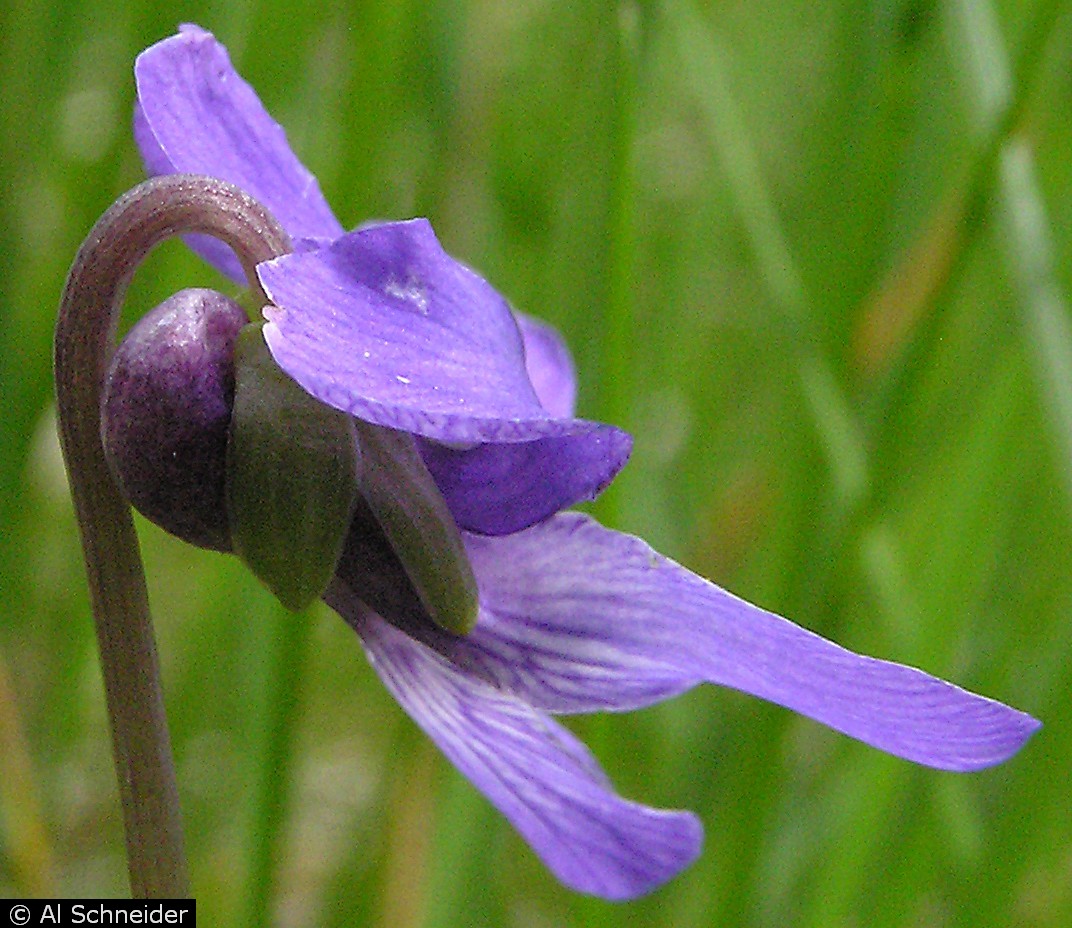“Big doesn't necessarily mean better. Sunflowers aren't better than violets." -- Edna Ferber
Classification
So where does this TINY flower fit in this BIG world?The term Viola stems directly from Greek mythology. The classical Latin name for violets is Viola, which is related to the Greek Vion, a variant of Io. The Greek legend tells of how Zeus fell in love with Io, the beautiful Greek priestess. When his wife, Hera, became jealous of the relationship, Zeus turned Io into a white heifer to protect her and provided the sweet-scented violet for her to graze on. The term sororia takes on the meaning, "of a sister." The scientific name Viola sororia means "sisterly, resembling other species". For further historical or interesting information, go to Facts.
Viola sororia is commonly known as the Common Blue Violet. It is also known as the Hooded Blue Violet, Meadow Violet, Chicken Fights, or Rooster Heads. This widespread species was originally known as Viola papilionacea in the older literature. However, some authors and botanists now place Viola papilionacea as a variety of Viola sororia Willd. Other synonymous scientific names include Viola floridana, Viola latiuscula, Viola priceana and many other variants of the species Viola sororia Willd.
The taxonomy of Viola sororia is questionable due to the plant's variable nature and its hybridization with at least four other species of genus Viola. The complete classification of Viola sororia is shown below with descriptions of why the organism is under each classification.
Domain: Eukarya - All members of the Eukarya are composed of cells with a true nucleus and membrane bound organelles. This domain includes all of the plants, animals, and fungi.
Kingdom: Plantae - Members of the plant kingdom have cellulose as the structural component of cell walls, chloroplasts, and go through photosynthesis to obtain nutrients.
Phylum: Magnoliophyta - Advanced venation patterns in leaves, a true flower which generally includes sepals, petals, stamens, and carpels where seeds are enclosed, double fertilization, and endosperm (nutritional tissue for embryo) formation are present characteristics of members in this phylum. Can you identify some of these characteristics in the pictures of Viola sororia above?
Class: Magnoliopsida (Dicotyeldons) - Six characteristics are present in the members of this class: two cotyledons (early seed leafs) in the embryo; leaf venation is net like; flower parts of four or five pedals; the vascular tissue is arranged in a ring formation rather than being scattered; presence of a main root; and the pollen grain has three openings. Looking at the pictures above, can you see why Viola sororia falls under this class?
Order: Violales L. - These members are morphologically heterogeneous and have a unicocular compound ovary (having a single compartment in the ovary or fruit) with mostly parietal placentation.
Family: Violaceae - Organisms have leaves that are often heart-shaped, sometimes toothed, or finely cut. Their flowers have five petals of unequal size with the lower ones forming a spur at the back of the flower (which contains nectar). Honey guidelines are present towards the spur. Members also have a one chambered seed capsule formed by three fused parts. Seeds of members are yellow or brown and rounded.
Genus: Viola - Organisms have unequal petals. Linear markings or honey guides on colored petals. See what these are used for specifically in the Reproduction page. Small, insignificant, cleistogamous flowers which never open may exist.
Species: Viola sororia - This species has the following characteristics: broad, heart-shaped leaves; flowers and leaves growing on separate stems that arise from the roots; inability of flowers to stand above the leaves; and the lowest petal does not have a spur
Phylogeny
Phylogentic trees allow us to see how the individual organism fits into the biodiversity of life. The following genetic tree was constructed to show how the species Viola sororia fits into each level from the Kingdom Plantae to the Class Magnoliopsida based on morphological characteristics. As you can see, the species is classified under the subkingdom Tracheophyta because it is a vascular plant. It is has seeds which explains its placement under the Spermatophyta group and so on.

Some organisms that belong to the same Class Magnoliopsida include: Helianthus annuus (Sunflower), Hedera helix (English Ivy), Sarracenia alata (Pale Pitcher Plant), and Rubus strigosus (The American Raspberry).
The following phylogenetic tree shows how Viola sororia fits into its Order, Phylum, and Genus, along with the other species that are included in the Genus Viola based on morphological characteristics. Though very similar, each species in the Genus Viola each has its own distinct characteristics. One closely related species to Viola sororia is the Sweet Violet, Viola odorata. Check out this organism to see how similar and different it is from the Common Blue Violet!

Now that you have seen where and how Viola sororia fits into the big picture, let us go a step further down to investigate where this species resides in terms of its Habitat.

